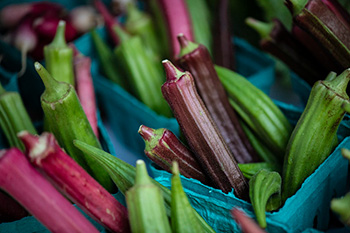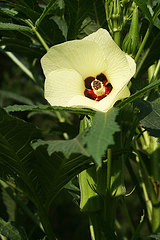Okra

A staple of Southern cuisine, okra came to the Americas from Western Africa. It is traditionally used to thicken soups or gumbos, or sometimes just served up fried. Florida gardeners appreciate okra’s heat tolerance and long growing season.
Characteristics
Culinarily, okra (Abelmoschus esculentus) is considered a vegetable. Botanically speaking, however, what we eat its edible fruit pod. And for anyone noticing that the okra flower looks like a hibiscus flower, excellent detective work! Okra is in the taxonomic group Malavaceae, the hibiscus family. Other family relatives include roselle and cotton.
Like hibiscus, okra has wide leaves and grows to the size of a medium shrub. Plant heights vary by cultivar and pruning practices. Most fall within the 3-6 foot range but check your seed source for more information. When the crop gets too tall to pick, you can clear the rows and plant again.
Okra varieties come in a kaleidoscope of colors. For Florida, look for ‘Annie Oakley II’, ‘Cajun Delight’, ‘Emerald’, ‘Clemson Spineless’, and ‘North and South’. ‘Cow’s Horn’ and ‘Blondy’ are also popular. Okra is increasingly valued as an ornamental, too. Varieties like ‘Alabama Red’ and ‘Burgundy’ offer bold, red foliage and striking flowers.

Planting and Care
Okra is well suited for Florida’s hot, humid summers. Plant this warm-season vegetable when evening temperatures are in the mid-fifties. South Florida can grow okra nearly year-round. In general, peak months stretch from March to November. Choose a sunny location with well-drained soil. Plan to soak the seeds in water for six hours prior to planting, too. This will boost germination.
Temperature and soil moisture are the limiting factors for okra’s growth rate. Okra grows best when the soil is above 65°F and is well watered. A balanced, slow-release fertilizer is a good choice for okra in the home vegetable garden. Controlling weeds ahead of planting is critical, too. Later, okra’s mature canopy shades the planting area and helps reduce weed competition.
From the planting date to harvest, okra is a fast-growing and high yield crop. Depending on the cultivar, you could be harvesting 50 to 70 days after planting. When okra starts to bloom, harvest will happen within a few days. Pick pods when they reach about two to three inches in length.
It’s a good idea to harvest okra early and often. The pods will be too tough to eat if they mature on the plant. At the peak of harvest season, you may need to pick daily. If your pods do stay on the plant too long, consider using them in flower arrangements. Okra pods make an eye-catching display.

While harvesting, be careful of the fine hairs on the stem, leaves, and fruit. Wearing long sleeves and rubber gloves will reduce the skin irritation. You may want to use shears, too, to cut through the fibrous stems.
Okra suffers damage from a wide range of insect and arachnid pests. Aphids, cucumber beetles, melon thrips, southern green stink bug, whiteflies, caterpillars, and spider mites are common but controllable. Scout early and practice integrated pest management. Okra is also susceptible to damage from root-knot nematodes. Cover crops like velvetbean (Mucuna pruriens) and sunn hemp (Crotalaria juncea) can help suppress nematodes when growing okra. Crop rotation is especially helpful in keeping nematode populations manageable.
For more information about okra contact your county Extension office.

Our thanks to Lisa Hickey, UF/IFAS Sustainable Ag & Food Systems Extension Agent for Manatee County Extension, for the contents of this article.
